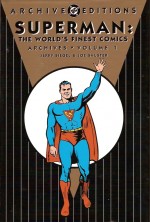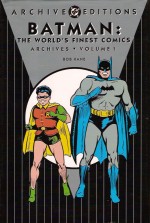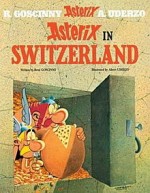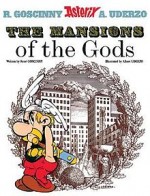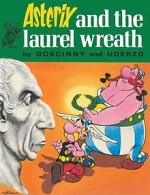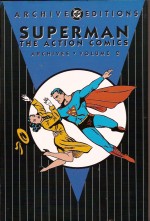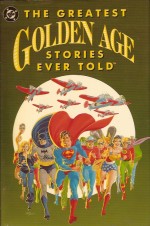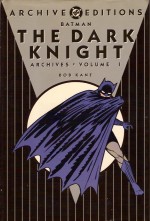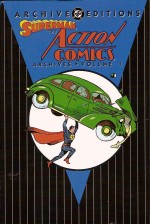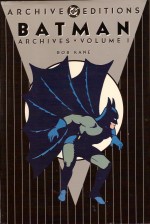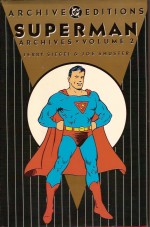
By Jerry Siegel & Joe Shuster and the Superman Studio (DC Comics)
ISBN: 0930289-76-5
By 1940 the intoxicating blend of sensational superlative action and social crusading which hallmarked the early exploits of the Man of Tomorrow had gradually expanded to encompass traditional cops-and-robbers crime-busting and outright fantasy and science fictional elements.
With a thrice-weekly radio serial, games, toys, a newspaper strip and a growing international media presence, Superman was swiftly becoming everybody’s hero, as this classic compendium re-presenting issues #5-8 of his landmark solo title ideally illustrates.
This first-edition deluxe hardback opens with a beguiling Foreword from author, strip-writer, historian and fervent fan Ron Goulart but no contents page or creator credits, so for the sake of expediency I’ve used information and story-titles from later collections to facilitate the review. Besides, if you just buy this brilliant, lavish, full-colour hardback treasure-trove, you’ll be too busy reading the glorious stories to worry over such petty details…
Superman #5 (Summer 1940) was the last quarterly issue: from the next the comicbook would be published every two months – a heartbreakingly tough schedule for Jerry Siegel, Joe Shuster and their burgeoning Superman Studio, then comprising Paul Cassidy, Leo Nowak, Dennis Neville and Jack Burnley. They would continue to expand rapidly in the months to come.
This issue is a superb combination of human drama, crime and wicked science beginning with ‘The Slot Machine Racket’, a particularly hard-hitting yarn exposing the rise in gambling machines and one-armed bandits targeting young kids and their meagre allowances, which, after a delightful ‘Super Strength: Rules for Summer Living’ health and exercise feature and a Supermen of America ad, continued in similar vein with ‘Campaign Against the Planet’, wherein corrupt politicians attempted to bribe, intimidate and ultimately end the crusading paper’s search for truth and justice.
After two-fisted genre prose vignette ‘Power of the Press’ by George Chute, arch-villainy manifested with the insidious, toxic threat of ‘Luthor’s Incense Machine’ and, after another text thriller ‘Murder in the Wind’ by Jack Willis, cartoon capers with dizzy Dachshund ‘Shorty’ and a joke page, Superman crushed Big Business chicanery by exposing the scandal of ‘The Wonder Drug’.
Issue #6, produced by Siegel and the Studio, with Shuster only overseeing and drawing key figures and faces, contained four more lengthy adventures and led with ‘Lois Lane, Murderer’ as the Man of Action saved his plucky journalistic rival from a dastardly frame up, then took a break while Chute’s text thriller ‘Too Big for Marbles’ and hobo humorist Driftin’Dave (by Alger) offered a change of pace, after which Superman rescued a small town from a gangster invasion in ‘Racketeer Terror in Gateston.’
Jack Burnley produced the Super Strength exercise tips which preceded ‘Terror Stalks San Caluma’ with our hero’s efforts to avert a disaster hampered by a blackmailer who’d discovered his secret identity. Legend in waiting Gardner Fox authored exotic prose murder-mystery ‘The Strangest Case’ and fact-page ‘Sporting Close-Ups!’ happily set up the stunning final act as the Man of Steel uncovered ‘The Construction Scam’ foiling and spectacularly fixing a corrupt company’s shoddy, death-trap buildings.
Superman #7(November/December1940) firstly found the Action Ace embroiled in local politics when he confronted ‘Metropolis’ Most Savage Racketeers’ and, after a George Papp Fantastic Facts feature and gypsy tall-tale text-piece ‘Rinaldo’s Revenge’ by G.B. Armbruster, proceeding to crush horrific man-made disasters orchestrated by property speculators in ‘The Exploding Citizens’…
Shorty played the canine fool again before the Man of Tomorrow stamped out City Hall corruption in ‘Superman’s Clean-Up Campaign’ – illustrated by Wayne Boring, who inked Shuster on the last tale of this issue where the Caped Crimebuster put villainous high society bandits ‘The Black Gang’ exactly where they belonged… behind iron bars.
Released in time for the Holiday Season, Superman #8 (cover-dated January-February 1941) was another spectacular and varied compendium containing four big adventures and a flurry of filler features.
The fantastic fantasy romp ‘The Giants of Professor Zee’ (illustrated by Paul Cassidy), found the hero battling man-made monsters and merciless greed and, following a page each of ‘Laffs’ and ‘Nature News…’, plumped for topical tension and suspense in ‘The Fifth Column’ (depicted by Boring & Don Komisarow) with Superman rounding up spies and saboteurs, before comprehensively cleaning up uncommon criminals in ‘The Carnival Crooks’ (Cassidy again).
Text tale ‘Knotty Problem’ by Ed Carlisle and Ray McGill’s ‘Snapshots with our Candid Cartoon Camera’ led to a breathtaking disaster tale which this splendid volume. The cover-featured ‘Perrone and the Drug Gang’ featured an increasingly rare comic-book outing for Shuster – inked by Boring – wherein the Metropolis Marvel battled doped-up thugs and the corrupt drug-dealing lawyers who controlled them for – illegal – profit.
One off the most enticing aspects of these volumes is the faithful and entrancing inclusion of all the covers, period ads, pin-ups and special offers… with the Superman merchandise page alone worth the price of admission…
My admiration for the stripped-down purity and power of these Golden Age tales is boundless. Nothing has ever come near them for joyous, child-like perfection and every genuine fan really should make them a permanent part of his or her life.
© 1940, 1990 DC Comics. All Rights Reserved.

